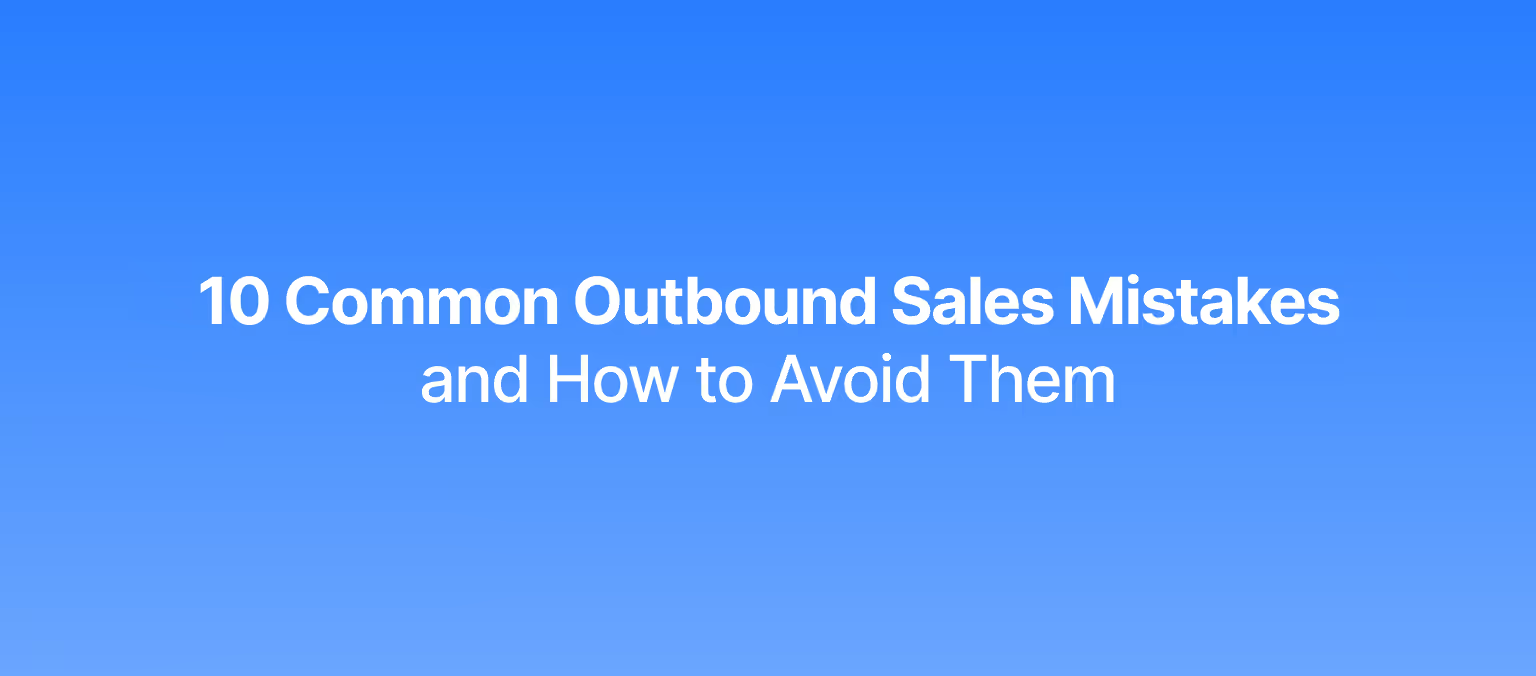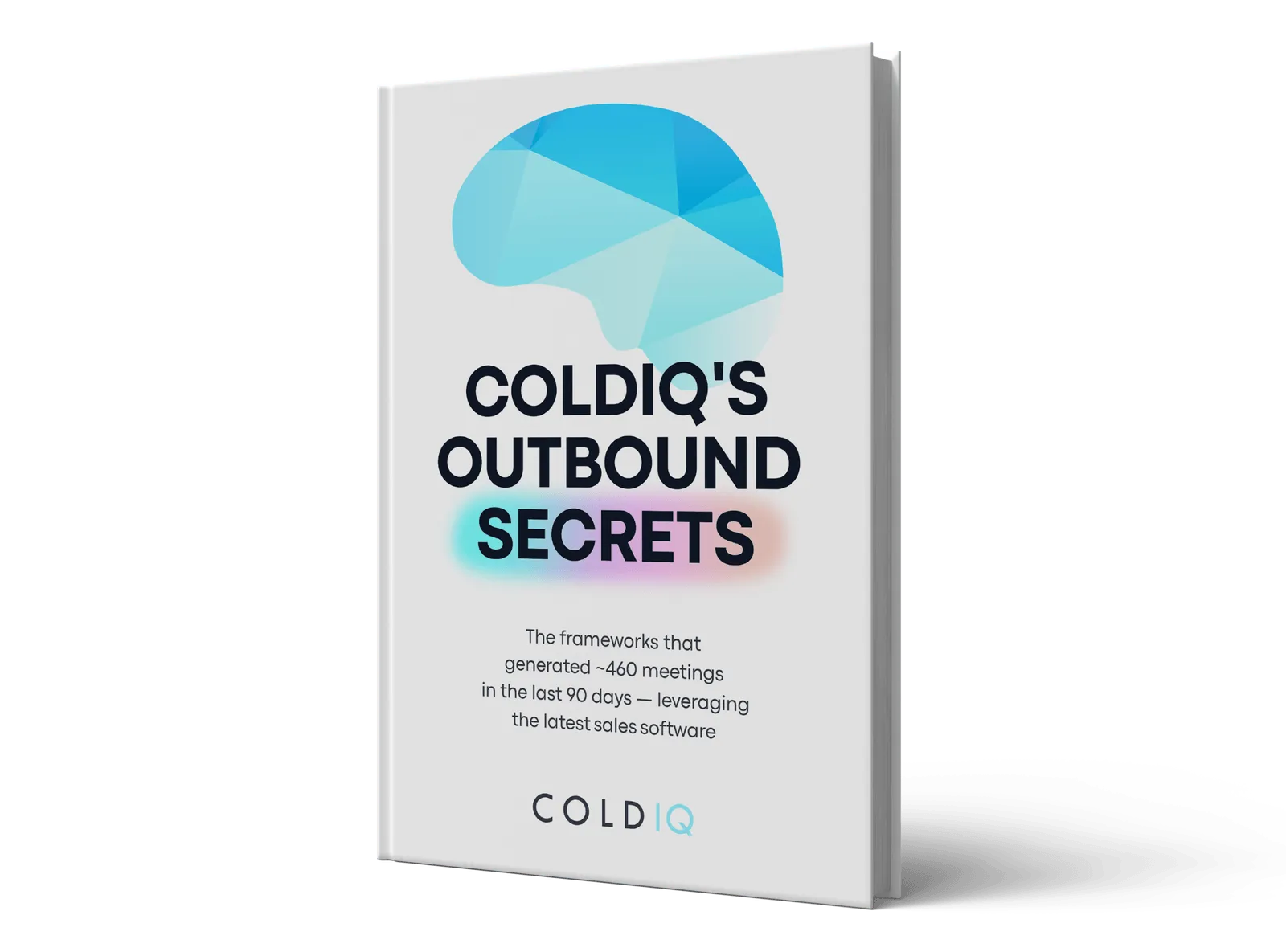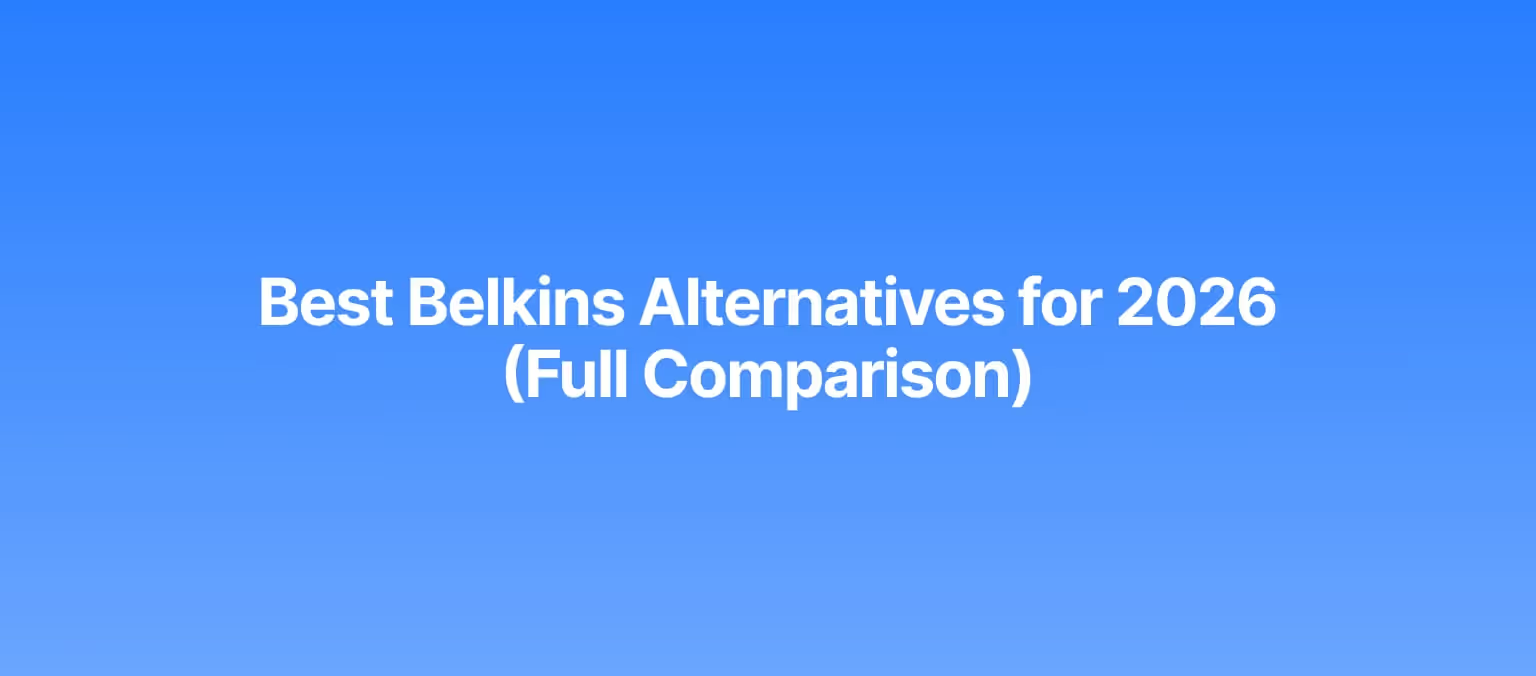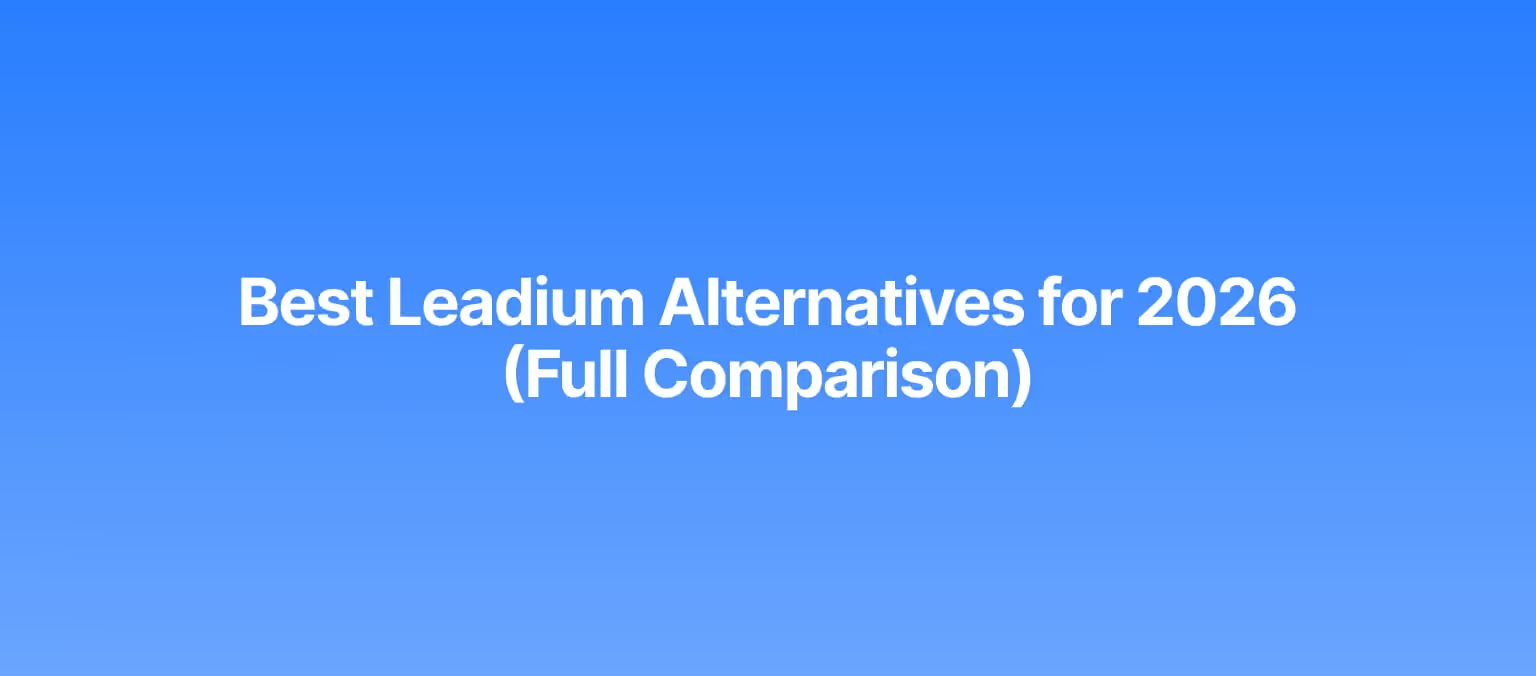If you’ve been sending cold emails and following up but yet no results, it’s not because outbound is broken.
It might be a process in your execution strategy. For instance, a Calendly report shows 44% of sales reps give up after one “no.” This, as well as 10 more mistakes that sales reps make, slow them down, kill response rates, and block deals from closing:
1. Targeting the wrong accounts
2. Not segmenting your ICP
3. Ignoring buyer personas
4. Sending generic messages
5. Relying on just one channel
6. Focusing on volume over fit
7. Letting your ICP go stale
8. Skipping discovery
9. Pitching too soon in the buyer journey
10. Not learning from feedback
Read on to see exactly how to fix each one, fast and simply.
1. Targeting Accounts That Don’t Match the ICP
One common mistake in outbound sales is reaching out to companies that don’t match this profile. This often happens when reps target businesses in the wrong industry, with an unsuitable company size, or without the budget to afford the product or service.
The result?
Time, effort, and resources are spent chasing leads that are unlikely to convert.
To avoid this, sales reps should use tools like Clay, ZoomInfo, Lemlist, or LinkedIn Sales Navigator to filter leads based on pre-defined criteria, ensuring that every prospect fits the ICP before initiating contact.
Tal Baker-Phillips, Customer Success Lead at Lemlist, provided a ChatGPT template you can use to find out more about your ICP. The template goes like this:
I'm prospecting a [ICP]. I'm looking to sell them a [tool/service] that:
- [value prop 1]
- [value prop 2]
- [value prop 3]
- [value prop 4]
- [value prop 5]
List their top 3 KPIs. Give me the most likely top 3 problems they're facing in hitting these KPIs. Also, give me their top 3 most likely lagging, leaning, and leading indicators. Give 3 suggestions on how my product can solve their top problem.
With a clear picture of who you’re targeting, you can streamline your outreach and messaging to address their specific pain points and challenges, increasing your chances of meaningful engagement.
Before you move on, let’s make sure you’re targeting the right people from the start. Here’s a simple checklist to validate whether a lead actually fits your ICP.
2. Failing to Segment Within the ICP
Just because a company fits your ideal customer profile doesn’t mean they all belong in the same bucket.
Another common mistake reps make is blasting the same message to every ICP-qualified lead without accounting for what makes each one different. Failing to segment within the ICP means treating all accounts that fit your ICP as a homogeneous group, ignoring their unique characteristics and needs.
When you treat them the same, your outreach sounds generic, and generic doesn’t convert.
For instance, a mid-market SaaS company with 15 reps will have very different priorities than an enterprise team with 200+. As a result, you need a smarter approach. Create smaller sub-segments within your ICP and break down your messaging to each one.
Effective segmentation means breaking down your ICP further based on firmographics, buyer personas, sales funnel stages, or even tech stack to create more focused, actionable groups.
Here’s how to segment your ICP smarter:
- By company size (e.g., 1–50, 51–250, 250+ employees)
- By industry (e.g., SaaS, Fintech, Manufacturing, etc.)
- By tech stack (e.g., using HubSpot vs. Salesforce)
- By buyer role (e.g., CEO, CMO, Head of RevOps)
- By lifecycle stage (cold, engaged, demo booked, closed
Also, create 2–3 outreach variations per segment – small tweaks go a long way. That way, your outreach feels personal, relevant, and far more likely to spark a real conversation, thereby resulting in better sales performance and ROI.
3. Ignoring Buyer Personas Inside ICP Accounts
Purchasing decisions in B2B are rarely made by one person. Even when you’re targeting the right company, your outreach can fall flat if you’re speaking to the wrong contact.
That’s because buying decisions often involve multiple stakeholders: the champion who believes in your solution, the decision-maker who controls the budget, and the one who may resist change.
Ignoring buyer personas within ICP accounts leads to contacting the wrong roles or focusing all your efforts on a single individual, which limits your ability to influence the deal effectively. Buyer personas help you speak your audience’s language and tailor your message to what actually matters to them, only if they’re accurate.
Rather than guessing, take time to map out the key stakeholders involved in the buying process. Sequence your outreach to engage each persona with messaging that addresses their unique role and concerns.
This approach increases your chances of building internal alignment and ultimately, closing the deal.
Also read: 8 Best CRM for Outbound Sales in 2025
Let’s make sure you’re reaching the right people inside the right companies. Use this quick persona map to guide your outreach:
4. Using Generic Messaging for All ICP Accounts
One-size-fits-all messaging reduces relevance, which is yet another mistake reps make in outbound sales. When you send the same cookie-cutter message to every prospect, it won't convert.
Just because a company fits your ICP doesn’t mean you can copy-paste your outreach and expect results. That’s why you need to personalize and make your messages relevant.
That doesn’t mean writing a brand-new email from scratch every time; it means using the right details to show you’ve done your homework. Gerardo Teijeira, GTM Team Lead at ColdIQ, shared some insights on why personalization and relevance are essential to outbound sales.
He says, “I think personalization is important in cold email, but it is not as important as many people think. What matters here is relevancy. A cold email must be relevant to the recipient. If it's ultra personalized but irrelevant, they won't take action or get to evaluate your solution.”
When asked how to make messaging better, Gerardo adds:
“People are now fatigued by plain AI personalization, and in order to work, you have to go a little bit deeper than personalizing the first sentence. Somehow, you have to stack different layers of personalization and relevance for cold email to work.”
Here are 5 quick ways to make your outreach more relevant:
- Mention a recent event (funding, hiring, product launch)
- Reference a tool they’re using or a tech gap
- Speak to a role-specific KPI (e.g., pipeline velocity for sales)
- Show you understand their challenge with similar companies
- Include a mini case study (1–2 lines) that proves results
Stack 2–3 of these in your message. It feels custom without taking hours.
5. Over-Relying on One Channel (e.g., Just Cold Email)
When it comes to outbound sales, relying solely on one channel, such as just sending cold emails, can limit your chances of connecting with and converting prospects.
This is why you should reach out through a combination of channels like cold emails to initiate contact, follow-up phone calls to add a human touch, LinkedIn direct messages, or personalized video messages to stand out and show genuine effort.
Michel Lieben, CEO and Founder of ColdIQ, shares a multichannel outreach cadence he uses to generate 145 leads for clients in the company. All processes are executed in Lemlist.
- Day 1 → They visit the target LinkedIn profile and send an email immediately after profile visit.
- Day 2 → They send an invite on LinkedIn
- Day 4 → They send a follow-up email with a slightly different angle, after which they wait for two scenarios.
- Day 9 → In the first scenario, the client may not accept the connection request. Here, we send a Loom walkthrough video on how we can help them.
- Day 9 → In the second scenario, they accept the connection request.
- Day 10 → We send a LinkedIn message a day after accepting the request, asking if they caught the previous message.
- Day 13 → We send a follow-up email to stay on top of their mind.
- Day 15 → We send a Loom walkthrough video as if they hadn’t accepted our request.
This approach allows us to engage prospects across multiple touchpoints, increasing the chances of converting them.
6. Prioritising Volume Over Fit
In the push to meet outreach targets, it’s easy for reps to fall into the trap of prioritising volume over fit. That usually looks like sales reps focusing on sending as many messages as possible (high volume), rather than ensuring they’re targeting the right people and companies (quality or fit).
While high numbers can look good on a dashboard, they don’t always translate into meaningful results. Expanding beyond your true ICP just to hit activity quotas often leads to weak conversations, poor engagement, and a bloated pipeline filled with leads that won’t convert.
Instead of obsessing over how many emails you send, focus on:
- % of replies that lead to qualified calls
- Demo-to-close rate
- Revenue per lead segment
- Time to first meaningful reply
- % of pipeline from ICP-fit accounts
Invest time in pinpointing the industries, company sizes, and job roles that best align with your solution. A smaller, highly targeted list of well-matched prospects will always outperform a massive list of random names.
7. Not Updating the ICP as the Market Evolves
The ICP isn’t something you set once and forget.
As markets shift, your product evolves, or customer needs change, your ideal customer profile should also evolve. Your ICP is your core customer base, and the foundation of a strong ICP is rich, up-to-date data.
It requires a mix of quantitative analysis (like win/loss rates and deal velocity) and qualitative insights (like feedback from AEs and customer success teams).
By refining your ICP, you can ensure your efforts align with customers who close faster, stay longer, and deliver greater lifetime value. What worked six months ago might no longer reflect where your real opportunities lie today.
When you keep targeting the same types of companies without reassessing fit, you risk wasting time on leads that no longer align with your direction. That’s why it’s important to revisit your ICP regularly, ideally every quarter. Use win/loss data, feedback from account executives, and insights from customer success teams to understand who’s converting, who’s churning, and why.
The sharper your ICP is, the more efficient and effective your outbound strategy becomes.
8. Skipping Discovery on “Obvious” ICP Accounts
Sometimes a prospect checks every ICP box, right industry, right size, right title, right budget, and it’s tempting to jump straight into pitching. After all, they look like a perfect fit.
But skipping or rushing the discovery process just because an account seems obvious is a costly mistake. Outbound success isn’t just about who fits your profile; it’s about who actually needs what you offer right now.
Assuming you already know their pain points leads to generic pitches and missed opportunities. That’s why even the “obvious” accounts need thoughtful, soft discovery upfront.
Dig into their:
- Recent news (e.g., layoffs, launches, leadership change)
- Their current sales tech stack
- Open job roles (to spot pain points)
- Past LinkedIn content or articles
- Mutual connections or recent activity
When you treat discovery as essential, not optional, your outreach becomes sharper, more relevant, and far more likely to resonate.
9. Neglecting the Prospect’s Stage in the Buyer Journey
Every buyer moves through several mental and practical steps before making a purchase: the awareness stage, where they first recognise a need or challenge; the consideration stage, where they investigate possible solutions; and the decision stage, when they are ready to compare vendors and make a choice.
Here's how to tailor your message based on where they are in the journey.
When a sales representative pitches too aggressively before understanding where the prospect is in their buyer journey, they risk alienating the potential customer and losing the sale. In many cases, the problem isn’t the pitch itself; it’s the timing. When you don’t consider where the prospect is in their buyer journey, you risk coming on too strong, too soon.
Anthony Natoli, Senior Account Executive at LinkedIn, advises, “When you reach out to the prospect, instead of trying to book a meeting, understand how they are engaging with your brand (if at all). Then, meet them where they are with appropriate messaging and pivot based on their response. Some might be ready to learn more about the problem you solve.
Some may want more content and need to be nurtured more. Some may not be qualified.”
When talking about the solution, he further adds, “Just because someone downloads an eBook doesn’t make them “sales ready.” They may be ready for more content and nurture. And then eventually be ready for a meeting...so don't ruin the relationship now.”
10. Not Using Feedback to Refine Outreach
Outbound is an iterative process.
If prospects aren’t responding, it’s not always a sign to give up; it’s a signal to dig in. Look at the data. And once you do land that call or demo, don’t let it end without a clear next step.
Here are a few ways to turn feedback into stronger outreach:
- Review reply patterns weekly (what got interest?)
- Categorize objections (e.g., timing, budget, relevance)
- Ask AEs: “Why did this deal move forward or stall?”
- Use call recordings to spot hesitation moments
- Iterate messaging monthly based on what’s working
Whether it’s sending a quote, scheduling a follow-up, or getting introduced to another decision-maker, clarity keeps the momentum alive. Afterward, send a quick thank-you email with a reminder of what’s next. It shows professionalism, builds trust, and keeps your prospect moving forward.
Conclusion
We’ve just uncovered 10 common outbound sales mistakes, and here’s the good news: each one you avoid gets you closer to building a smarter, more effective sales engine. Use this checklist before you hit send on any campaign:
But if you’re tired of guessing your way through outbound sales, ColdIQ makes it easier. Our sales experts leverage the right AI tools for outbound sales and execute the right strategy to help you connect with high-fit leads that actually convert. Book a demo and let’s help you fill your pipeline with better leads, faster.
Want to go deeper?
You can also book a GTM Sales Strategy call with our team. We’ll break down your current approach, map out quick wins, and design a scalable outbound system tailored to your ICP.
No matter if you're starting from scratch or looking to sharpen your existing process, we'll help you turn outbound into a predictable growth engine.




.avif)

.svg)
.avif)



.avif)
